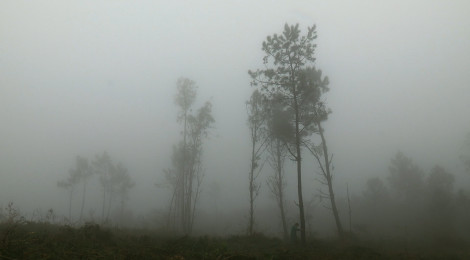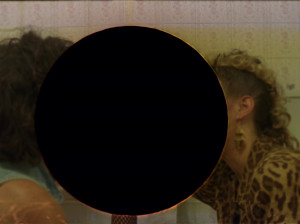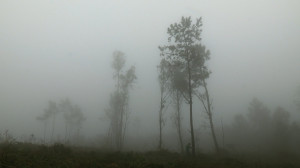
Bradford International Film Festival: The ‘Other’ Spanish Cinema
Mediático presents a report from Rebecca Naughten on the three new Spanish movies, Un ramo de cactus, El futuro, and Costa da morte, recently screened at the Bradford International Film Festival. Rebecca has a blog on Spanish cinema, Nobody Knows Anybody.
The 20th edition of the Bradford International Film Festival ran between the 27th March and 6th April 2014 at the National Media Museum with a diverse programme of films from around the world, including retrospectives of James Benning, Brian Cox, and Sally Potter, and Close-Up sections on producer/distributor Charles Urban, and the crime films of Yoshitarõ Nomura. I managed to catch a bit of (almost) everything but had timed my visit specifically to see the three Spanish films playing at the festival: Un ramo de cactus / A Bouquet of Cactus (Pablo Llorca, 2013), El futuro / The Future (Luis López Carrasco, 2013), and Costa da Morte / Coast of Death (Lois Patiño, 2013).
All three were UK premieres, with Un ramo de cactus and Costa da Morte playing in the Bradford UNESCO City of Film European Competition, but they have garnered attention at multiple film festivals elsewhere in the past year. Collectively they offer an illustration of the diversity of cinema currently being made in Spain and what Caimán Cuadernos de Cine have labelled ‘el otro cine español’ / ‘the other Spanish cinema’. While ‘other’ (or ‘marginal’, or ‘alternative’, in so far as it offers an alternative to the industrial norm) cinema is almost always present in some form, in the special issue that Caimán CdC dedicated to the subject last September Carlos Losilla argued that there are four factors that make the current manifestation in Spain distinct from what has happened in the past: it is more abundant than ever (the number of Spanish filmmakers being mentioned in film festival dispatches has been increasingly noticeable in the last 12-18 months – even if these films have struggled to be exhibited in Spain, the outside world (including Bradford) has been paying attention); plurality – multiple methods and styles of filmmaking are in operation; boldness – they are pushing the boundaries of traditional narrative and sometimes taking extreme forms; it centres on a community of individuals who are working together and helping each other, connected both by the internet and a desire to share experiences and projects (Losilla 2013: 6).
Of the three Spanish directors whose work screened in Bradford, all of whom feature on Caimán CdC’s list of filmmakers pertaining to this ‘other’ cinema, Pablo Llorca is the example of how this ‘collective impulse’ in contemporary Spanish film is actually an on-going and constantly renewing process (he is nine films into his career), but also an indication of the aesthetic range encompassed by this set of cineastes. His films are rough around the edges, much like his central character in this instance (played by Pedro Casablanc), but they are made with sincerity and warmth, and a sense of righteous indignation at where Spain is being taken by politicians. The most overtly political of the three films, Un ramo de cactus equates the working of the land with the raising of a child – you get out what you put in – as Alfonso (Casablanc), a farmer who is estranged from his family, attempts to shape the upbringing of his grandson and to instil in him an appreciation of the natural world and a questioning of the status quo. At the same time, Llorca implicitly and explicitly criticises the expansion of the consumer society (via the lifestyles and priorities of Alfonso’s extended family) and also the austerity measures that have cut back Spanish public services (via the impact on Alfonso’s circle of acquaintances). The film is admirably no-frills, by which I mean that conviction has been prioritised over presentation (in keeping with the actual narrative), and the pared-back aesthetic complements the evident sincerity with which the film has been made.
Much more experimental in form is El futuro, the solo directorial debut of Luis López Carrasco (who has directed two features as part of the collective Los Hijos) which takes place during a house party in the aftermath of the PSOE’s 1982 election victory. Filmed on 16mm to look as if it was made in 1982 – Pepi, Luci, Bom (Pedro Almodóvar, 1980) and Iván Zulueta’s cult classic Arrebato / Rapture (1980) are visual points of reference (de Pedro 2013) – the film nonetheless casts a caustic glance towards the present. Opening the film with the audio of Felipe González’s 1982 victory speech playing over a black screen not only frames the film in political terms, but also gives the viewer the space to think about how Spain has moved on from that era – in relation to certain issues (economic crisis, the autonomous regions), the speech could have been made yesterday. Likewise the inconsequential nature of many of the conversations we overhear suggests that this party could be taking place at any point in the last thirty years (fashions aside). In fact López Carrasco has questioned whether we can actually say that what is on screen is the past, or indeed fiction, because the manner in which it was filmed (over the course of a weekend with actors and non-actors who were unsure as to whether they were being filmed / recorded at any given moment) means that it could be a 1980s-themed fancy dress party (de Pedro, ibid). The blurring of the fictional and the documental is a recurring theme within this ‘other’ cinema, examples include Arraianos (Eloy Enciso, 2013) and La Plaga / The Plague Year (Neus Ballús, 2013), although I would argue that the slippage is relatively minor in this instance because despite the fly-on-the-wall feel to El futuro there are sections that are more obviously staged / framed and in which sound and image are synchronised for clarity (which is not the case for large parts of the film). It is one of these framed conversations on the periphery of the party, on the subject of ETA, which most firmly anchors the film in its reconstructed era rather than the present (although, again, centring on an issue that Spain has not yet resolved).
López Carrasco’s film was the most experimental of the Spanish trio. As mentioned above, sound and image are sometimes unsynchronised, which gives the sensation of being in a crowded room where you’re not necessarily hearing those in front of you but snippets of conversations coming from elsewhere. El futuro is an immersive experience – we are at the party – rather than a plot-driven narrative, and in some ways it could be regarded as a silent film with contemporaneous musical accompaniment[i], as more often than not we are reading facial expressions and body language to gauge the moods and personalities of the partygoers rather than anything we directly hear them say (the song lyrics linger in the mind far longer than the conversations). The camera itself begins to feel the effects of the party in the last section, ‘spacing out’ and becoming an actual silent film, before ‘capturing’ the partygoers in a series of freeze frames in which their faces are obscured by large black circles that appear on the screen – not dissimilar to ‘cue marks’ (signalling to the projectionist that the reel is ending). These marks were not ‘created’ by López Carrasco but laboratory marks ‘found’ on the negative itself that he then decided to use as part of the fabric of the film.[ii] A nod towards the censorship that would have negated previous depictions of illicit activities? Maybe, but having seen Arrebato for the first time only the week before, I’m inclined to say that the camera is consuming them, and that a point is being made about the consumer consumed (there are several different types of ‘consumption’ within the film, including conversations about consumer items such as microwaves).[iii] The generation onscreen thought that democracy was achieved in 1982 (rather than an on-going process) and proceeded to celebrate that by conflating freedom with consumerism. The confusion of consumerism and freedom (and by extension a tendency towards wilful political blindness) represents a thematic overlap with Un ramo de cactus, although López Carrasco makes no moral judgement (in contrast to Llorca).
The third of the films (and my favourite of the three – I have reviewed it in more detail here), Costa da Morte, shares common ground with Un ramo de cactus in terms of extolling the natural world – we see the land being worked and harvested in a variety of settings and on a breathtaking scale. Investigating this ‘other’ Spanish cinema is my new project but my main reason for wanting to see these three films in Bradford was that, despite researching Spanish cinema for more than ten years, I have seen comparatively few Spanish films on the big screen due to the paucity of Spanish titles distributed in the UK. I have watched a number of Lois Patiño’s short films online and I knew that something was lost in viewing them on a small screen, not least because of the importance of distance to the images he creates. Preceded by his sublimely beautiful short film Montaña en sombra / Mountain in Shadow (2012), I watched Costa da Morte on the National Media Museum’s IMAX screen – although not in IMAX format, the position of the seats in relation to the screen meant that I was sitting roughly level with the middle of the image, which afforded me an appropriately bird’s eye view of this landscape documentary.
Following the eponymous stretch of Galician coastline, but also going inland to incorporate a diverse range of open spaces, Patiño celebrates the vastness and power of nature by filming from such a distance that when humans do appear in shot, usually on the bottom periphery of the frame, they are rendered ant-like by the magnitude of the natural world. As with El futuro there are spaces between the sound and image but, rather than creating a disjuncture, the effect here draws you closer to the image and envelops the viewer into the film: Patiño’s intention was to set up a dialogue between the intimacy of the physical experience of people in their places of work and the immensity of the landscape (Iglesias 2013: 24). The sound in Costa da Morte was recorded separately which means that we hear with crystal precision the (supposed) conversations and stories of the tiny humans we see at edge of frame, and we hear their breathing so close by that they could be sitting alongside us even while they are visually so far away. The distance elevates the conversations – about the history and legend of the landscape, as well as the centrality of the spaces (sea, port, forest, quarry, mountains, coast) to the work people are shown to be engaged in – to the universal as we are often unable to tell which of the small figures onscreen we are listening to. In the process, Costa da Morte reveals the many different elements and voices of the land and landscape without privileging one aspect or view over another. Walt Whitman’s Leaves of Grass came to mind towards the end of the film:
‘Do I contradict myself?
Very well then….I contradict myself;
I am large….I contain multitudes.’
That stands not just for Patiño’s landscape poem, but also for the kaleidoscope of burgeoning voices being discovered in current Spanish cinema by film festivals worldwide, and of which I caught a glimpse in Bradford.
References:
de Pedro, G. (2013) – ‘El futuro ya no es lo que era. Entrevista con Luis López Carrasco a propósito de su primer largometraje, El futuro‘, Blogs&Docs, 1st October, http://www.blogsandocs.com/?p=5736
Iglesias, E. (2013) – ‘Lois Patiño: “Quería retratar un espacio mítico”, Caimán Cuadernos de Cine, no.19, September, p.24.
López Carrasco, L. (2013) – ‘Luis López Carrasco: Las canciones de “El Futuro”’, Numerocero, 11th November, http://numerocero.es/cine/articulo/luis-lopez-carrasco-canciones-futuro/1977
Losilla, C. (2013) – ‘Un impulsivo colectivo’, Caimán Cuadernos de Cine, no.19, September, pp.6-8.
[i] The director has explained his choice of songs – most of which have gloriously surreal lyrics – in an article in Numerocero (2013).
[ii] Information received courtesy of Michael Pattison.
[iii] López Carrasco has suggested that a vampiric camera is one of several possible interpretations (de Pedro, ibid).









